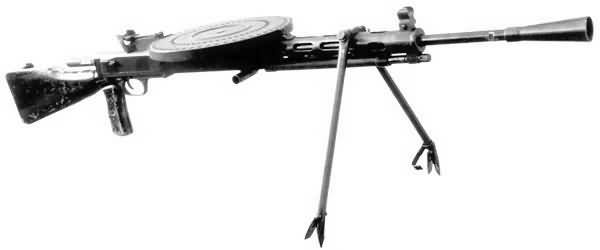The 7.62 mm Ruchnoy Pulemyot DP (Degtyaryova pakhotnyi) was adopted by the Soviet army in 1928. It is extremely simple, yet remarkably reliable and robust. It remained the standard light gun until the 50's, and large numbers of them were used by the North Korean and Chinese Communists in the Korean war. The secret of the DP was the simple locking device, which makes use of locking flaps on the bolt, pushed out by the firing pin. The DP proved resistant to dust and dirt, and free from any serious vices.
However, the DP did have some distinct faults. The return spring weakened with heat from the hot barrel, and the bipod legs bent and broke from rough handling. The DPM, shown above, moved the return spring to the rear of the bolt and protruded over the small of the butt in a cylindrical housing, where it prevented the gunner from grasping the gun in the usual way, and so induced the fitting of a pistol grip.
The bipod was replaced by a stronger version, attached to the barrel casing, which raised the roll center of the gun and made it easier to hold upright.
Still, the heavy, awkward flat pan magazine was easily damaged, and a continuous operational problem. The RP46 is a belt-fed version of the DPM, and yet can accept the pan magazine if the belt feed mechanism is removed. The RP46 has a higher rate of fire (650 rpm) but is two pounds heavier than the DPM, and has a distinctive carrying handle.


